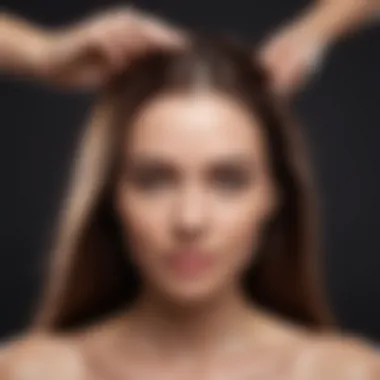Unlock the Secrets to Long, Luscious Hair: Expert Tips and Techniques Revealed


Beauty Tips and Tricks
Achieving long, luscious hair requires a combination of dedication and the right techniques. When it comes to haircare, consistency is key. Establishing a skincare routine that caters to your hair's needs is essential. Incorporating nourishing hair masks and oils can help maintain hair health. Experimenting with different hairstyles to avoid constant tension on the roots also plays a crucial role. Additionally, protecting your hair from environmental stressors like UV rays and pollution is important to prevent damage and breakage. With the right haircare hacks and a mindful approach to maintaining hair health, you can set the foundation for achieving the long, healthy hair you desire.
Understanding Hair Growth
Achieving long, luscious hair starts with understanding the intricate process of hair growth. This fundamental knowledge lays the foundation for implementing effective strategies to nurture your locks for optimal length and vitality. By comprehensively grasping the stages of the hair growth cycle and the various factors influencing it, you equip yourself with the insights needed to tailor your hair care routine to suit your specific needs.
Hair Growth Cycle
The hair growth cycle consists of three main phases: the Anagen Phase, the Catagen Phase, and the Telogen Phase. Each phase plays a crucial role in determining the length and quality of your hair, making it essential to delve deeper into these stages for a deeper comprehension of hair growth.
Anagen Phase
The Anagen Phase, known as the growth phase, is a pivotal stage where the hair actively grows. During this phase, the cells in the hair follicle rapidly divide, contributing to significant hair length. Understanding the Anagen Phase allows you to appreciate the importance of providing essential nutrients to support this growth period effectively. This phase's unique feature lies in its prolonged duration, making it a favorable stage for nurturing long, healthy hair. Leveraging the benefits of the Anagen Phase is key to maximizing your hair growth potential.
Catagen Phase
In contrast to the growth phase, the Catagen Phase is a transitional stage where hair growth ceases. This brief phase marks the end of active hair growth and prepares the hair follicle for the next cycle. While the Catagen Phase may seem less impactful, its role in renewing the hair follicle is crucial for sustaining healthy hair growth. Recognizing the significance of this phase in the context of your hair care routine can aid in preventing unnecessary breakage and promoting overall hair health.
Telogen Phase
The Telogen Phase, also referred to as the resting phase, is where the hair follicle remains inactive before eventually shedding the hair strand. Although this phase may seem like a period of minimal activity, it is essential for the natural renewal of hair. Embracing the unique characteristics of the Telogen Phase enables you to adopt practices that support seamless transitions between growth cycles, ultimately leading to the maintenance of long and vibrant hair.
Factors Affecting Hair Growth
In addition to the hair growth cycle, several factors influence the rate and quality of hair growth. Genetics, nutrition, and stress levels play pivotal roles in shaping the health and longevity of your hair. Understanding how these elements intertwine with the hair growth process empowers you to make informed decisions that facilitate the growth and maintenance of your desired hair length.
Genetics
Genetics, as a fundamental factor affecting hair growth, determine various aspects of your hair, including its thickness, texture, and growth potential. While genetic predispositions are inherent, implementing targeted hair care strategies can help optimize the growth capacity dictated by your genetic makeup. Acknowledging the influence of genetics on your hair enables you to develop personalized routines that cater to your unique hair attributes.


Nutrition
Nutrition plays a significant role in promoting healthy hair growth, emphasizing the importance of a balanced diet rich in essential nutrients. Proteins, omega-3 fatty acids, and vitamins are pivotal for nourishing your hair follicles and supporting robust growth. Incorporating nutrient-dense foods into your diet can address deficiencies that might impede the hair growth process, enhancing the overall quality and length of your hair.
Stress Levels
High stress levels can negatively impact hair growth by disrupting the natural cycles and function of hair follicles. Chronic stress may lead to hair thinning and loss, highlighting the interconnectedness of mental well-being and hair health. Managing stress through relaxation techniques and self-care practices is crucial for maintaining optimal hair growth conditions and preserving the length and strength of your hair.
Optimizing Hair Care Routine
In the quest for long, healthy hair, optimizing your hair care routine plays a pivotal role. Implementing effective hair care practices can significantly contribute to the overall health and appearance of your hair. By focusing on the specific elements of optimizing hair care routine, such as proper washing techniques, effective moisturization, and minimizing heat damage, you can ensure that your hair remains strong, nourished, and primed for growth. The benefits of honing your hair care routine extend beyond mere aesthetics; they encompass the health and resilience of your hair strands, promoting longevity and vitality.
Proper Washing Techniques
Choosing the Right Shampoo
When it comes to choosing the right shampoo, one must consider various factors to tailor this essential hair care step to their specific needs. The choice of shampoo plays a crucial role in cleansing the scalp, removing impurities, and maintaining the natural balance of oils on the scalp. Opting for a shampoo that aligns with your hair type, whether dry, oily, or normal, is imperative for achieving optimal results. Look for key characteristics such as sulfate-free formulations, nourishing ingredients like keratin or argan oil, and p H-balanced formulas, which can help enhance the health and appearance of your hair. Selecting the right shampoo is a popular choice in this article due to its foundational importance in any hair care routine, making it a beneficial step towards nurturing long and luscious hair. While each shampoo type may have its advantages and disadvantages, it is crucial to choose one that best caters to your hair's unique needs.
Conditioning Tips
The significance of conditioning in your hair care routine cannot be overstated. Conditioning not only helps in detangling hair strands but also provides essential moisture and nourishment, enhancing the overall health of your hair. Conditioning tips focus on selecting the right product for your hair type, whether it is a deep conditioner for intense hydration or a lightweight conditioner for daily use. The key characteristic of conditioning lies in its ability to seal the hair cuticle, resulting in smoother, more manageable hair. This aspect makes conditioning a popular choice in this article as it contributes significantly to maintaining long and healthy hair. While conditioning offers numerous benefits, such as improved softness and shine, it is essential to be mindful of potential disadvantages like product buildup, requiring occasional clarifying treatments for optimal hair health.
Effective Moisturization
Hair Oils
The use of hair oils has been a longstanding practice for promoting hair health and growth. Hair oils serve as natural emollients, providing deep nourishment and hydration to the hair and scalp. The key characteristic of hair oils lies in their ability to penetrate the hair shaft, replenishing lost moisture and improving hair elasticity. Opting for hair oils is a popular choice in this article due to their versatility and effectiveness in addressing various hair concerns, from dryness to frizz control. The unique feature of hair oils is their ability to be customized according to individual needs, whether using argan oil for shine or coconut oil for nourishment. While the advantages of hair oils include enhanced hydration and scalp health, it is essential to consider potential disadvantages such as greasiness, requiring proper application techniques for optimal results.
Leave-In Conditioners
Leave-in conditioners offer a practical solution for ensuring your hair remains hydrated and protected throughout the day. These lightweight formulations provide ongoing moisture to the hair, making them ideal for individuals with dry or damaged hair. The key characteristic of leave-in conditioners is their ability to detangle hair, reduce frizz, and provide thermal protection, promoting overall hair manageability. They are a popular choice in this article as they streamline the moisturization process and offer long-lasting benefits for hair health. The unique feature of leave-in conditioners is their leave-in application, eliminating the need for rinsing and providing continuous nourishment. While the advantages of leave-in conditioners include enhanced hydration and styling ease, it is crucial to be mindful of potential drawbacks such as product buildup, necessitating periodic cleansing for optimal hair health.


Minimizing Heat Damage
Heat Styling Precautions
Heat styling can have detrimental effects on the health and longevity of your hair if not approached with caution. Heat styling precautions involve adopting protective measures to minimize damage from styling tools such as flat irons, curling wands, and blow dryers. The key characteristic of heat styling precautions is their role in preserving the hair's structural integrity by reducing excessive heat exposure and preventing thermal damage. These precautions are a beneficial choice in this article as they underscore the importance of maintaining hair strength and resilience in the face of regular heat styling. The unique feature of heat styling precautions is their adaptability to various heat styling techniques, offering a tailored approach to protecting hair from potential harm. While the advantages of heat styling precautions include reduced breakage and split ends, it is crucial to consider potential disadvantages such as styling limitations or longer styling times in exchange for healthier hair.
Heat-Free Styling Options
Embracing heat-free styling options provides a gentle yet effective way of achieving desired hairstyles without compromising hair health. These alternatives involve using techniques such as air drying, braiding, or twisting to style the hair without the use of heat. The key characteristic of heat-free styling options is their ability to create versatile looks while minimizing the risk of heat-induced damage. They are a popular choice in this article due to their capacity to protect the hair from excessive heat exposure and maintain its natural texture and strength. The unique feature of heat-free styling options is their versatility, offering a range of styles from effortless waves to intricate updos without reliance on heat styling tools. While the advantages of heat-free styling options include reduced damage and increased hair resilience, it is important to note potential drawbacks such as longer setting times or trade-offs in achieving specific heat-styled looks for the sake of hair health.
Nutritional Support for Long Hair
In this comprehensive guide to achieving long, luxurious hair, the section on Nutritional Support for Long Hair plays a pivotal role in understanding the underlying principles of hair health. By delving into the importance of proper nutrition, this article sheds light on how essential nutrients contribute to the overall vitality and length of your hair. Nutritional Support for Long Hair is a cornerstone of any hair care regimen, as it provides the foundation for strong, healthy hair growth.
Essential Nutrients for Hair Health
Proteins
Proteins are the building blocks of hair, playing a crucial role in strengthening the hair shaft and promoting growth. In the context of this article, Proteins are highlighted as a key component due to their ability to repair damaged hair, increase thickness, and maintain overall hair health. The unique feature of Proteins lies in their amino acid structure, which aids in fortifying the hair structure and preventing breakage. While Proteins offer numerous benefits for long hair, it's essential to note that an excessive intake may lead to protein overload, potentially causing dryness and brittleness.
Omega-3 Fatty Acids
Omega-3 Fatty Acids are renowned for their anti-inflammatory properties and their ability to nourish hair follicles, promoting healthy hair growth. Within the context of this article, Omega-3 Fatty Acids are emphasized for their role in maintaining scalp health, reducing hair loss, and enhancing hair luster. The unique feature of Omega-3 Fatty Acids lies in their ability to moisturize the scalp and strengthen hair follicles. However, an imbalance in Omega-3 intake may result in oily scalp or excessive hair shedding.
Vitamins
Vitamins are essential micronutrients that support various functions in the body, including hair growth and maintenance. Within the scope of this article, Vitamins are crucial for enhancing hair strength, promoting shine, and preventing hair damage. The key characteristic of Vitamins is their role in maintaining a healthy scalp environment conducive to hair growth. The unique feature of Vitamins lies in their antioxidant properties, which protect hair strands from environmental damage. Nevertheless, excessive Vitamin intake may lead to adverse effects, underscoring the importance of balance in dietary supplementation.
Hydration and Hair Growth
Hydration is a critical factor in hair growth, with water intake directly influencing the health and appearance of your hair. Understanding the importance of proper hydration and its impact on hair growth is paramount in the quest for long, luscious locks. Adequate water intake plays a vital role in maintaining scalp health, promoting hair elasticity, and preventing breakage.


Importance of Water Intake
The significance of proper hydration, specifically the importance of water intake, cannot be overstated when aiming for optimal hair health. Water plays a fundamental role in nourishing hair follicles, ensuring they remain hydrated and functioning efficiently. Highlighting the key characteristic of water intake in hair growth emphasizes its ability to enhance hair elasticity and prevent dry, brittle strands. Adequate hydration through water consumption regulates the natural sebum production on the scalp, contributing to overall hair health and vitality.
Styling Strategies for Long Hair
Styling your long hair is a crucial aspect when aiming for optimal hair health and appearance. It plays a significant role in not just the aesthetics but also in maintaining the overall health of your locks. By focusing on proper styling techniques, you can minimize damage and breakage, allowing your hair to grow longer and stronger. Picking the right styles and methods can make a substantial difference in the journey to achieve long, luscious hair.
Protective Hairstyles
Braids
Braids are a timeless and versatile protective hairstyle that can benefit your hair in various ways. Their primary advantage lies in the fact that they help prevent damage by keeping the hair strands secure and protected. Braids are a popular choice for those looking to maintain the health of their hair while still showcasing a stylish look. They are known for their ability to reduce tangles and breakage, making them an excellent option for individuals striving for long hair. However, it is essential to avoid excessive tightness when braiding to prevent any strain on the hair follicles.
Buns
Buns offer a classic yet effective way to protect and style long hair. One of the key characteristics of buns is that they keep the hair off the shoulders and back, reducing friction and potential damage. This type of protective style is popular for its convenience and ability to preserve the hair's health. Buns can help prevent split ends by keeping the ends tucked away and secure. While buns are a go-to option for many, it's essential to ensure they are not secured too tightly to avoid unnecessary pressure on the scalp.
Trimming and Maintenance
Frequency of Trims
Determining the right frequency for trimming your hair is crucial for long-term hair growth and health. Regular trims help remove split ends and prevent further damage, allowing your hair to maintain its length without breakage. The key characteristic of frequent trims is that they promote healthier hair by eliminating dry, brittle ends. While it might seem counterintuitive to cut your hair for it to grow, trimming is essential for overall hair vitality.
Split End Prevention
Preventing split ends is a vital aspect of maintaining long, healthy hair. Split end prevention techniques focus on keeping the hair ends moisturized and protected. By using nourishing hair oils and avoiding excessive heat styling, you can significantly reduce the occurrence of split ends. Incorporating regular deep conditioning treatments can also help in preventing split ends and promoting overall hair health. It's essential to handle your hair gently and avoid harsh brushing to minimize the risk of splits.
Lifestyle Habits and Long Hair
To cultivate and maintain long, beautiful hair, adopting healthy lifestyle habits is indispensable. Lifestyle habits play a pivotal role in the overall health and appearance of your hair. By paying attention to key factors such as diet, exercise, and stress management, you can significantly enhance the quality and vitality of your locks. Healthy lifestyle practices not only promote optimum hair growth but also contribute to your overall well-being. Embracing a holistic approach that encompasses both internal and external care is essential for achieving and sustaining long, luxurious hair.
Stress Management
When it comes to maintaining healthy hair, stress management is a critical aspect that often gets overlooked. The impact of stress on hair health can be profound, leading to issues such as hair loss, breakage, and dullness. High stress levels trigger hormonal imbalances that can disrupt the hair growth cycle, resulting in unmanageable hair. Incorporating stress management techniques into your routine, such as meditation, yoga, or mindfulness practices, can help in mitigating these effects. By reducing stress, you create an environment that is conducive to robust hair growth and overall hair vitality.
Impact on Hair Health
The specific aspect of stress management's impact on hair health lies in its ability to disrupt the hair follicle's normal functioning. Stress-induced hormonal changes can push hair follicles into a premature resting phase, halting regular growth. Consequently, this can lead to increased shedding and decreased hair volume. Understanding the detrimental impact of stress on hair health emphasizes the need for effective stress management strategies in your hair care regimen. By addressing stress levels, you can safeguard your hair's health and promote optimal growth and appearance.







